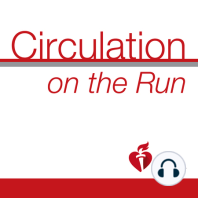25 min listen
Circulation January 12, 2021 Issue
ratings:
Length:
22 minutes
Released:
Jan 11, 2021
Format:
Podcast episode
Description
This week's episode features authors David Kasss and Kavita Sharma as they join Greg to discuss their article "Myocardial Gene Expression Signatures in Human Heart Failure with Preserved Ejection Fraction." TRANSCRIPT BELOW: Dr. Carolyn Lam: Welcome to Circulation on the Run. Your weekly podcast, summary, and backstage pass to the journal and its editors. We're your co-hosts, I'm Dr. Carolyn Lam, associate editor from the National Heart Center and Duke National University of Singapore. Dr. Greg Hundley: And I'm Dr. Greg Hundley, director of the Pauley Heart Center at VCU Health in Richmond, Virginia. Dr. Carolyn Lam: I am so excited about today's feature paper. It talks about my favorite topic, heart failure with preserved ejection fraction, or HFpEF, this time giving us really novel myocardial gene expression signatures in human HFpEF. Can't wait to go to that, but I also can't wait to share about some of the really cool papers in today's issue. Dr. Carolyn Lam: Now, we know that mitral valve-in-valve and valve-in-ring are alternatives to surgical reoperation in patients with recurrent mitral valve failure after a previous surgical valve repair or replacement. But, what are the outcomes after transcatheter mitral valve-in-valve or valve-in-ring procedures? And what is the clinical significance of post-procedure residual mitral stenosis or regurgitation? Well, we're going to find out in today's paper. Dr. Dvir from Hebrew University in Israel and authors examine the midterm outcomes in the Valve-in-Valve International Data registry, which is a multicenter collaboration and rolling cases performed between March, 2006 and 2020, in 90 centers worldwide. Dr. Greg Hundley: Wow, Carolyn. So what did they find? Dr. Carolyn Lam: Well, a total of 1079 patients were included with a median follow-up of 492 days. 4-year Kaplan-Meier survival rate was 62.5% in the valve-in-valve, versus 49.5% in valve-in-ring procedures. Significant residual mitral stenosis occurred in 8.2% of the valve-in-valve, and 12% of the valve-in-ring patients. Significant residual mitral regurgitation was more common in valve-in-ring patients. The correlates for residue mitral stenosis were smaller true internal diameter, younger age, and larger body mass index. The only correlate for residual mitral regurgitation was a valve-in-ring procedure. Significant residual mitral stenosis and residual mitral regurgitation were both independently associated with repeat mitral valve replacement. Dr. Carolyn Lam: So, significant residual mitral stenosis and/or mitral regurgitation were not infrequent after mitral valve-in-valve and valve-in-ring procedures, and we're both associated a need for repeat valve replacement, so strategies to improve post-procedural hemodynamics in mitral valve-in-valve and valve-in-ring should certainly be further explored. Dr. Greg Hundley: Very nice, Carolyn. Well, my first paper, it really involves results from the American Heart Association COVID-19 Cardiovascular Disease registry, and it comes from our own associate editor, Dr. Justin Grodin from UT Southwestern Medical Center. So Carolyn, obesity may contribute to adverse outcomes in coronavirus disease, or COVID-19. However, studies of large, broadly-generalizable patient populations are still lacking in the effect of body mass index, or BMI, on COVID-19 outcomes, particularly in younger, adults remains uncertain. Dr. Carolyn Lam: Yeah. It is an important question. And so, what did they find? Dr. Greg Hundley: Well, Carolyn, obese patients are more likely to be hospitalized with COVID-19, and are at higher risk of in-hospital death or mechanical ventilation, in particular, if they're young. So individuals less than age 50 years. Obese patients are also at higher risk for venous thromboembolism and dialysis. These observations support clear public health messaging and rigorous adherence to COVID-19 prevention strategies in all obese individuals, regardless of age. Dr. Carolyn Lam: Wow. An imp
Released:
Jan 11, 2021
Format:
Podcast episode
Titles in the series (100)
Circulation November 1, 2016 Issue: Dr. Carolyn Lam: Welcome to Circulation On The Run, your weekly podcast summary and backstage pass to the journal and its editors. I'm Dr. Carolyn Lam, Associate Editor from The National Heart Center and Duke National University of Singapore.... by Circulation on the Run
